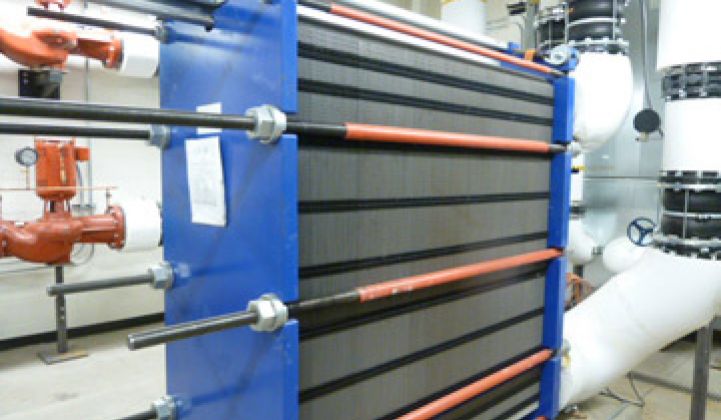RENO, Nevada -- Dean Parker will soon put a couple of 250-kilowatt natural gas boilers on eBay.
Parker, the executive director of the Peppermill Casino here, replaced four boilers with a combined capacity of one megawatt at the casino last year with a geothermal system that provides all of the heating and hot water required by the facility.
In all, that’s 2.1 million square feet of real estate, two outdoor pools, spas, 1,635 rooms and 16 theme bars heated by, and provided with hot water from, energy from the bowels of the earth.
While Parker will keep two boilers for backup, two other boilers will get auctioned off.
One of the most stunning things about geothermal technology is the size. The now-silent boilers (see photo below) occupy the bulk of the interior space of a facilities building. The heat transfer unit -- a set of 160 plates (see photo) that extract heat from water pumped from 4,400 feet from underground and transfer that energy to the water that circulates in the casino’s pipes -- looks like it could almost fit in the back of a pick-up truck.
‘That’s it?’ is the common reaction.
The geothermal well looks even more mundane. The injection and recovery well heads are located under a steel door in the parking lot that takes up less space than two parking spots. The wells and necessary equipment together cost $9.5 million.
“We save $2.2 million on natural gas a year,” he said.
Approximately 900 gallons of water per minute pass through the plates on average, but the entire system barely makes any sound. (See video.) Like any hotel, demand for hot water spikes at various times of the day: the Peppermill can increase the hot water it extracts to 2,200 gallons a minute.
In the coming months, Parker will connect the company’s snow removal equipment to the geothermal system. And if it didn’t require a major retrofit, he said he’d even consider getting some of the casino’s air conditioning power from geothermal.
The sticking point for expansion isn’t the lack of underground hot water but current regulations. In Nevada, consumers can only qualify for renewable credits on the first megawatt of power. (In total, the Peppermill consumes 6 megawatts of energy.)
“I wish we could get more,” he said.
Geothermal is the cornerstone of Nevada’s plan to capitalize on renewables. The fractured geology of the northern part of the state is one of the largest, and most studied, geothermal basins in the country. The university has in turn become the epicenter for research on the topic. In all, Nevada hopes to get 25 percent of its energy from renewables by 2025, encouraged in part though tax credits and other benefits.
Unlike solar or wind, geothermal developers and users are engaged in a continual dance with the source of their energy. If you extract too much water too fast, power production declines because the well doesn’t have time to replenish itself, said Paul Thomsen, director of policy and business development at Ormat.
The wells also lose temperature over time and can lose a substantial part of their value after 15 to 20 years, although wells can be replenished through injections of hot water.
Geothermal is also admittedly partly based on luck. The casino sits right over a subterranean geothermal stream. Seven miles away, the same water resource provides the heat for Ormat’s Galena power plant, which provides 100 megawatts of electricity to the region.
The first $3.5 million spent on the deep well was something of a gamble: there was no guarantee how much water it would find and how hot it would be. The company pays a wholesale rate of 9 cents a kilowatt hour for power so the margin for error was also not tremendous.
While Galena produces electricity, the Peppermill simply extracts heat from its geothermal wells. Water cools as it travels. By the time it gets to the casino, it is only 174 degrees Fahrenheit, or not hot enough to economically generate power. Potentially, it could tap into warmer (300-plus degrees Fahrenheit) water for power generation by drilling deeper, but, again, there’s that one megawatt cap to consider.
The 4,400-foot deep well and 160-plate radiator was actually not the first geo project for the company. It was a culmination of various projects.
Back in the '80s, the company dug a shallow geothermal well that struck 120 degrees Fahrenheit water. The heat was used to heat swimming pools and saunas. Since then, the casino periodically upgraded and expanded its wells. In total, it has invested $9.7 million in geothermal.



